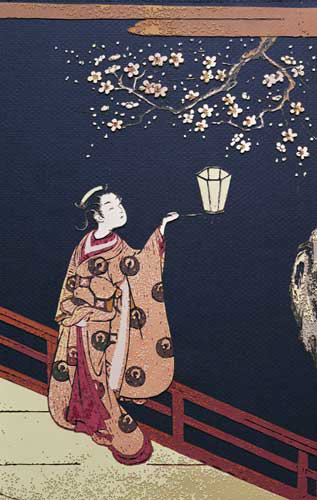
“I was born in Brazil and grew up in the ’70s under a climate of political distress,” said artist Vik Muniz in a 2003 TED lecture. “I was forced to learn to communicate in a very specific way, like a semiotic black market. You couldn’t really say what you wanted to say. You had to invent ways of doing it. You didn’t trust information very much.”
This cuts straight to the core of Muniz’s work, which has consistently not been what it appears to be, and is also so much more. It is approachable, often immediately likeable. It is often clever, rife with puzzles, and layers of how it can be seen or understood.
His new body of work is comprised of recreations of work by various artists of note. Several among these are of famous woodblock prints from early Japanese artists, such as Harunobu and Hokusai. Others are of paintings by the likes of Albrecht Dürer, Winslow Homer, and Willen Van Aelst.
Muniz presents the works as photos of collages that he created out of construction paper. The concept is similar to a series he created in 2008, but those works stuck to black and white only. These are full color, a deliberately greater challenge the artist assumes, and which he meets to stunning effect.
As with the previous series, he has each original piece broken down into its component colors. Each color is meticulously cut out, down to the flecks of white in the waves in “Northeaster, after Winslow Homer.” The pieces of paper are layered, one on top of the other, until the image is complete, and finally photographed. Much of the paper is textured, thus the pieces are often not adhered securely to each other, allowing shadows to be cast. This adds a depth to the work, giving it a three-dimensional quality. It’s difficult to believe you’re not actually looking at the collage when you see the picture. Even very close up, you have to convince yourself that you are looking at a photograph.
Further messing with the “you’re not seeing what you think you’re seeing” idea is the scale of the work. The photos are big, measuring up to 110 by 71 inches and no smaller than 53 3/4 by 40 inches. The collages themselves, however, are small, somewhere in the realm of 16 x 12 inches. What amounts to barely noticeably details at the original size, such as those shadows, become dramatic with this much magnification.
Why Muniz chose these particular works isn’t entirely evident. One can speculate that perhaps it’s the detailed process each artist undertook to create their work, which Muniz honors by using his own laborious process. Harunobu, for example, was an innovator, the first to create full-color prints, mimicked here by Muniz with his own move to full color. Of course he may simply like the works that he settled on.
Putting aside the playfulness and eye/brain trickery, and layers of art-historical references, these pieces are simply beautiful. By adding back in all of the nuances, Muniz makes them remarkable.
